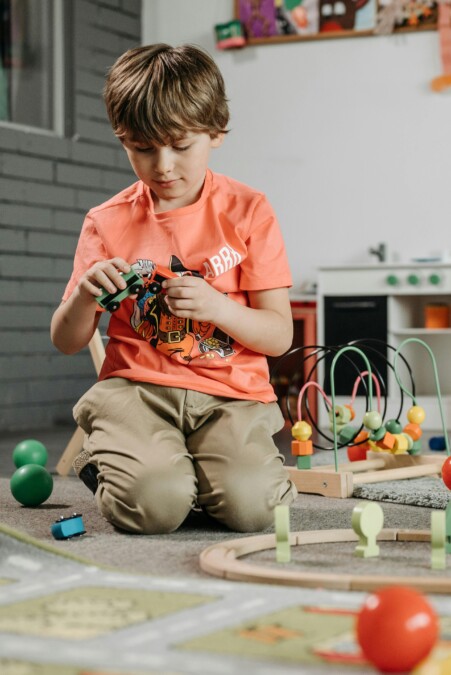Imagine a therapy room filled with toys and creativity, where children grow, learn, and overcome challenges: this is the world of play therapy; a transformative approach changing how occupational therapists and psychologists support children facing emotional, social, and academic struggles. From improving academic performance, enhancing emotional regulation, helping neurodivergent children build social skills, and empowering adolescents handling anxiety and depression; the applications of play therapy are expanding to become a powerful intervention with positive implications in human development. But why is it so effective? And how can OTs and psychologists can make the best use of it? This article focuses on the recent studies about play therapy, the neuroscience behind its effectiveness, and its newly identified applications.
What is Play Therapy?
Playing is a fundamental right and a central component of human development (Elbeltagi et al., 2023). The main focus of play therapy is identifying psychosocial issues; through play, children foster an identity, comprehend the world, and learn how to act and interact with others, thus the environment. Play therapy uses games and creativity as a therapeutic tool to address emotional, social, and cognitive disturbances, by creating a safe and structured space where children and teenagers can express themselves.
Recent studies have shown that creative methods promote neuroplasticity, due to their interplay with perception, cognition, emotion, and behavior. Strang (2024) explored the neuroscience behind art therapy and other creativity-based interventions, discovering that Play Therapy activates mirror neurons and promotes the formation of new neural circuits. This means that games and creative activities, not only help children process their emotions but also enhance their ability to learn and adapt to challenging situations. Play Therapy provides a holistic approach that addresses academic and emotional needs; playing children feel better while also reshaping brain functions, leading to long-term improvements in emotional and cognitive development.
How Can Play Therapy Assist Children with Learning Disabilities?
One of the most compelling findings in recent research is the impact of play therapy on the academic performance of children with learning disabilities. Xu (2025) conducted a study that showed parent-child play therapy greatly enhanced the reading ability of 10-12-year-old Chinese boys with cognitive processing difficulties. Incorporating parent-child play activities into literacy instruction resulted in improved literacy skills and positive affective changes among primary school children. Through collaborative and familiar games, the parent and child communication improved, fostering a more supportive learning environment.
Children with neurodevelopmental differences often face emotional challenges associated with academic frustration and difficulties in social adaptation. Parent-child play therapy enhances emotional regulation and reduces attention deficits in children with learning disabilities (Xu, 2025). Research has pointed out that play therapy enables children to freely express and work through their emotions in a controlled environment, thereby facilitating the development of self-control. Improved self-regulation abilities positively impact children’s academic performance by allowing them to cope with pressure, concentrate better on tasks, and interact more effectively in social settings. For children with autism spectrum disorder (ASD), play therapy offers a unique set of benefits. Research suggests that play therapy helps the sensory integration for neurodivergent children. Through play, social relationships and community improve, allowing children to grow self-confidence, self-esteem, resilience, curiosity, and coping skills. Moreover, it has a positive impact on family relationships; nurtures the parent-child relationship, and also alleviates work-related stress for parents who are often overwhelmed by the pressures of raising autistic children (Elbeltagi et al., 2023).
Play Therapy in Occupational Therapy
Play therapy becomes even more effective when put together with occupational therapy. Children with ASD can utilize and test out sensory experiences in a safe environment (Elbeltagi et al., 2023); Playing helps to develop trust through the release of oxytocin, a bonding and stress-relief hormone. As a consequence, children learn coping skills while taking care of their emotional well-being.
A 2023 study emphasizes that play therapy helps improve social skills and communication. Empathy is a crucial social skill, particularly challenging for people with disabilities and other conditions. Duan et al. (2024) found that cognitive-behavioral therapy based on sports games can be used to foster empathy in children with intellectual developmental disorders. The combination of therapeutic techniques along with other forms of exercise is not only for treating the physical aspect of conditions, it also improves social and emotional aspects. For occupational therapists and psychologists, this research further provides the notion that there can be play-centered approaches to children with IDD.
Play therapy is not limited to young children, as it offers a way to incorporate physical activity into therapeutic interventions, making it a valuable tool for treating mild to moderate depression in adolescents. Huang et al. (2024) conducted a randomized controlled trial to explore the effects of behavioral activation (BA) play therapy on depressed adolescents. The study found that combining BA with improvisational games improved adolescents’ motivation for treatment and reduced the symptoms. Increasing light physical activity by just one hour a day can decrease depression scores by 8-11% (Huang et al, 2024). This is highly important given the close relationship between physical activity and mental health.
On the other hand, play-based methods and storytelling are highly effective in several conditions. Abdi et al. (2025) compared the effects of play therapy and storytelling on the anxiety levels of hospitalized children. Separation anxiety is often accompanied by symptoms like sleep disorders, poor appetite, and difficulty cooperating with medical staff. The study found that both interventions were effective; storytelling had a greater impact on reducing anxiety. Play therapy is a powerful tool, that combined with storytelling can be an effective alternative or complementary approach for reducing anxiety in children.
For psychologists and OTs, play therapy highlights the importance of tailoring interventions to the specific needs of each person. Whether you are an occupational therapist working on sensory integration, academic performance, or a psychologist addressing social difficulties, anxiety, or depression, play therapy offers innovative tools to enhance your practice.
REFERENCES:
- Xu, T. (2025). Parent-child play therapy effect on 10 to 12-year-old students' reading performance: A case of Chinese male students with learning disabilities. BMC Psychology, 13, 156. https://doi.org/10.1186/s40359-025-02436-2
- Elbeltagi, R., Al-Beltagi, M., Saeed, N. K., & Alhawamdeh, R. (2023). Play therapy in children with autism: Its role, implications, and limitations. World Journal of Clinical Pediatrics, 12(1), 1-22. https://doi.org/10.5409/wjcp.v12.i1.1
- Duan, G., Wang, Y., Hou, H. et al. Effect of cognitive-behavioral therapy-based physical play intervention on empathic ability of children with intellectual disabilities. Sci Rep 14, 30171 (2024). https://doi.org/10.1038/s41598-024-80066-1
- Huang, X., Chen, Y., Luo, J., Wang, D., Yang, C., Luo, W., et al. (2024). The effect of behavioral activation play therapy in adolescents with depression: A study protocol for a randomized controlled trial. PLoS ONE, 19(6), e0304084. https://doi.org/10.1371/journal.pone.0304084
- Abdi, F., Karamoozian, A., Lotfilou, M., et al. (2025). Effect of play therapy and storytelling on the anxiety level of hospitalized children: A randomized controlled trial. BMC Complementary Medicine and Therapies, 25, 23. https://doi.org/10.1186/s12906-025-04767-4
- Strang, C. E. (2024). Art therapy and neuroscience: Evidence, limits, and myths. Frontiers in Psychology, 15, 1484481. doi: 10.3389/fpsyg.2024.1484481. https://pubmed.ncbi.nlm.nih.gov/39417019/











